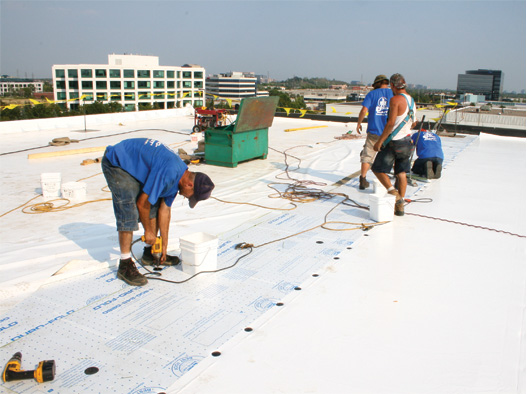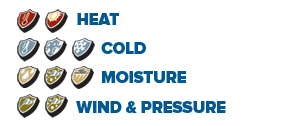SUSTAINABLE ROOFING:
A PRACTICAL APPROACH
TO ROOF RETROFITS.
There is a serious barrier in the roofing world that handicaps us in trying to achieve sustainable and environmentally friendly roofing practices. It's a barrier that is costing consumers unnecessarily large monetary and energy losses. We can make sustainable roof retrofits and enormous progress in energy conservation within buildings by making a tiny shift in our beliefs about roofing philosophy. It's a common belief that a roofing system is completely deteriorated and must be completely discarded at the end of its service life. This is a myth. There are few instances where it is practical to completely remove the entire roofing system when doing a roof retrofit project. We don't use this type of reasoning when performing retrofits to any other building component or portions of the building envelope. There is no expiry on most of the components of a roof system Insulation that is kept dry will perform for an indefinite length of time. The waterproofing layer of the roof system is generally the only component of the roofing system that actually requires cyclical replacement.
Buildings account for 30% of energy use and 27% of greenhouse gas emissions in Canada. Few building systems have a shorter life span or are replaced as frequently as roofing systems. With traditional roofing practices, roofs produce huge amounts of waste at the end of each service life. There are few areas of the building that can achieve such huge improvement towards sustainability and energy conservation as roof retrofits.
At the Oak Ridge National Laboratory (ORNL) Sustainable Low-Slope Roofing Workshop in 1996 a Sustainable Roof System was defined as "a roofing system that is designed, constructed, maintained, rehabilitated and demolished with an emphasis throughout its lifecycle on using natural resources effectively and preserving the global environment."
 A sustainable roof conserves energy, has an extended service life and reduces or eliminates waste all at a cost comparable to a traditional roof.
A sustainable roof conserves energy, has an extended service life and reduces or eliminates waste all at a cost comparable to a traditional roof.
The requirements of a sustainable roof are as follows. It conserves energy. It has an extended service life and it reduces or eliminates waste. An extended service life can be designed into the system. Building practice can be adopted that will reduce or even eliminate waste. Most importantly, all of the above can be achieved at a cost comparable to more traditional roofing systems.
To minimize the burden on the environment we can design roof retrofits to be completely sustainable at the end of the service life of the new roofing system. A roof retrofit can be designed to reduce waste in the first retrofit and to totally eliminate waste in future retrofits. Most importantly, it can be implemented at a competitive price.
Have a look at a theoretical model to test the viability of this approach. As an example, let's compare a typical roof retrofit specification on a 20,000 square foot industrial building with the following conditions: The building is 20 feet high, 100 feet wide and 200 feet long. The roof has an existing R-9 in the roof and R-8 in the walls.
Remove stone from roof 80,000 lbs gravel to be disposed Completely remove old roof 40,000 lbs waste to landfill Install vapor barrier Install R-9 insulation Install tar-based product
Remove stone from roof 80,000 lbs gravel to be disposed Verify for moisture and rectify Keep R-9 insulation Removal savings buys new R-20 Old roof becomes vapor barrier Install recyclable product
These two specifications will cost approximately the same. However, the results are drastically different.
From an energy perspective, the building with the typical roof retrofit is no improvement over the old roof. The roof that was designed for sustainability now has a total insulation R-Value of 29. It is serious that all sustainable roofing practices are implemented. If not, this building will unfortunately continue to generate 20 tons of waste at the end of each service life.
What is exciting is that the building with the sustainable roof retrofit now has an average R-Value of 22. This will greatly reduce the energy consumed from heating and cooling. Using a white non-reflective roof membrane generates other energy savings. The obvious return on investment is substantial savings on energy bills from reduced heating and cooling costs. All that's needed to do is change the retrofit design and start saving.
Note: The above sustainable design is now a Self Drying Roof Assembly with numerous benefits. This will ensure that no moisture is accumulated in this portion of the building envelope Note: This article is not encouraging the practice of installing roof overlays over wet substrates. References: NRCA Roofing Manual 2010 Condensation Control and Reroofing. Moisture Control in Buildings: A Key Factor in Mold Prevention 2nd Edition ASTM Intercouncil Towards Sustainable Roofing Presentation by Dr. Karen Lui, National Research Council



